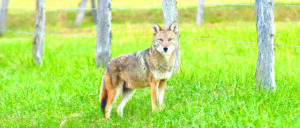By Dr. Beth Leermakers
A coyote followed my 60 lb. dog and me on our morning walk the other day. We’d been seeing the same one in our Dallas neighborhood for a few weeks, and he’s probably just looking for food. I’m not usually too concerned about coyotes, since they’ve never gotten very close to my big dogs. However, this one was becoming a bit too comfortable around people, and it made me nervous. My canine “pack” is full, and we’re not accepting new members.

Photo courtesy of the Humane Society of the United States
An Animal Control Officer from Dallas Animal Services spent a week hazing the little guy (or gal — I didn’t want to get close enough to find out). Apparently he’d been circling people who were walking their small dogs. When I spoke with the ACO, she recommended that I walk toward the coyote, hopefully getting my dog to bark or growl at him.
Although the signs on the walking trail (Be Aware! Increased Coyote Presence in This Area) say, “Stand your ground. Yell and wave your arms to scare off the coyote,” the ACO told me yelling hadn’t worked with this fellow. Instead, she recommended carrying a plastic bottle filled with rocks. After the coyote didn’t back off when my dog and I got within 15 feet of him, I went home and filled a plastic jar with pennies. I’ve been carrying that noisemaker since then, and we haven’t seen the coyote. Knock on wood.
Coyotes are usually antisocial animals who avoid people. When urban coyotes learn that people aren’t a threat, they lose their fear and approach people. Because coyotes control the populations of rodents, insects and other small mammals (rabbits and foxes), they are beneficial to the ecosystem.
We don’t want to harm them; we just want them to move on to another, less populated area.
How to Prevent
Coyote Problems
Don’t feed coyotes. In May of 2022, a 2-year-old boy was attacked and injured by a coyote while sitting on his porch near the White Rock Trail. “Intentional or unintentional feeding is part of every escalated coyote case we’ve had since the attack,” says Ann Barnes, a Dallas Animal Services assistant general manager.
“Probably 50 percent of [the people], ignore us with the feedings and it continues to escalate,” she said. In response, Dallas City Council is considering an anti-feeding ordinance to prevent more people from intentionally giving wild animals food and stop animals like coyotes from getting too comfortable around humans.
If you’re feeding community cats, don’t leave the food outside all the time. Feed the cats at the same time every day. Put the food out and then pick it up after the cats have a chance to eat.
To keep coyotes out of your yard, keep your pets (especially cats and small dogs) and pet food inside. If a coyote enters your yard, use the hazing techniques to chase him away. Turning a water hose on him may be an effective deterrent.
Never run away from a coyote. Instead, be large and loud. Make noise and move toward the coyote. If he doesn’t run away immediately, you may need to get closer to him (I’m not sure how close is too close) and ramp up your hazing (see below).
Keep your dog close to you. Walk your dog on a 6-foot (or shorter) leash. The ACO told me that most coyote attacks occur when dogs are off-leash or on retractable leashes. If you’re walking a small dog, pick the dog up and hold her close to your body when you see a coyote.
Call the Coyote Hotline to report a coyote sighting: 469-676-9813. I called after my “too-close encounter,” and the ACO I’d met returned my call, again advising me to carry a bottle with rocks.
Coyote Hazing Methods
Hazing means using deterrents to move a coyote out of the area or discourage him from getting too close to people. Hazing can help maintain coyotes’ fear of humans and discourage them from entering backyards and hanging out near walking trails and playgrounds. When you’re hazing them, be sure you don’t chase them into traffic.
The Humane Society of the United States recommends using several different hazing tools so coyotes don’t get too used to a single one. Here are a few to try:
• Yelling and waving your arms while approaching the coyote (maybe that works for some)
• Noisemakers: whistles; air horns; bells; shaker cans/bottles filled with rocks, marbles or pennies; pots, lids or pie pans to bang together
• Projectiles: small rocks, sticks, cans, tennis or rubber balls
• Water: hoses, water guns or spray bottles with vinegar water
• Pepper spray or bear repellent
I’m going to keep carrying my jar full of pennies. Hopefully, I won’t need to use it any time soon.
